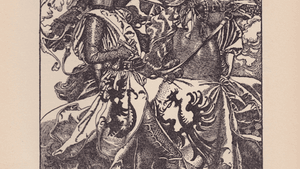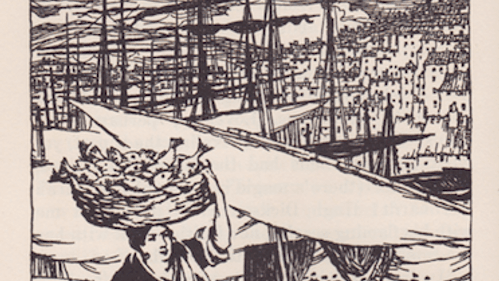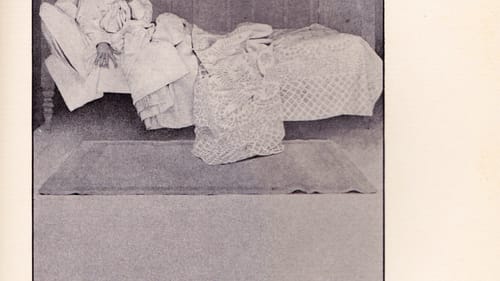Stay in the Loop
BSR publishes on a weekly schedule, with an email newsletter every Wednesday and Thursday morning. There’s no paywall, and subscribing is always free.
When applied art became fine art
Drexel University's Howard Pyle, His Students, and the Golden Age of American Illustration

Howard Pyle was a rock star. In an era long before communication as we know it, most of America knew his name. His illustrations sold magazines and books regardless of the content, and while American artists headed to Europe to study at painting academies there, European illustrators studied Pyle’s methods and artistry.
Illustrator and innovator
Born in Delaware in 1853, Pyle was a savvy innovator and prolific artist. He knew how to use and expand upon the late 19th century’s burgeoning technical advances that put magazines, illustrated books, and print reproductions within reach of the masses. Trained as an easel painter at New York’s Art Students League, he found he could earn his living as an illustrator and mastered all its requisite media.
There was no formal training for illustrators, so to impart what he’d learned and created, Pyle searched for a place to teach. The Pennsylvania Academy of the Fine Arts turned down his proposal for an illustration academy (the divide between “fine art” and “applied art”). Pyle went to the Drexel Institute of Art, Science and Industry (notice the primacy of “art” in the name), where A.J. Drexel saw a way to cement his belief that art should be part of every person’s education. He retained the artist to teach there.
From 1894 to 1900 in his Drexel studio – and later from the plein air school he established in Wilmington, Delaware – Pyle sent forth a generation of successful illustrators. His and his students’ works appear in Drexel’s lively and illuminating exhibition Howard Pyle, His Students, and the Golden Age of American Illustration.
Depicting life
Pyle insisted that his students work from life, with real props, creating art to evoke feeling rather than merely showing off technique. By all accounts he was a vivid, inspiring, and memorable mentor, and this vitality is evident – even overpowering – in the exhibited works.
Packed with items by Pyle and 19 of his disciples, the exhibition is presented in a high-ceilinged 1876 jewel-box Frank Furness building, a former bank. This method of display gives the exhibition and its vibrant images a surprisingly welcoming period feel.

The works appear in several different media. Colorful, action-packed scenes hang near black-and-white oils (some illustration originals were painted that way for better reproduction). Works both huge and tiny, illustrated books in glass cases, engravings, pen-and-ink drawings: all reinforce the variety of Pyle’s many students and his encouragement of their individual styles.
Red Rose Girls
As well as advances in illustration art and techniques, Pyle pioneered equality for women artists. Included are fine works from the “Red Rose Girls” (Jessie Willcox Smith, Elizabeth Shippen Green, and Violet Oakley). In one of the period-style display cases rests a line engraving by Smith (“Rittenhouse Square, Philadelphia”) in an unusual style for this artist. Italia, a stunning, gilded Oakley work (painted in 1944 as a poster for Italian war relief) hangs in the exhibition’s first room. Its rich buttery tones and architectural details perfectly echo the intricate Furness brickwork above it.
Maxfield Parrish’s magnificent A Florentine Fête hangs in the second room, a huge stop-you-in-your tracks mural created for the girls’ dining room at Curtis Publishing. However, the mural does not represent the familiar “Parrish color palette.” Neither do two small unusual Parrish works on paper in nearby glass cases: The Blue Room (an unexpectedly eerie echo of Munch’s The Scream) and the strange image of The Knickerbocker Indian.

This exhibition is filled with the works of widely recognized artists such as N.C. Wyeth, Frank Schoonover, and Norman Rockwell (a Pyle devotee, though not a student), but there are also compelling pieces by lesser-known names such as Alice Barber Stephens and Harvey Dunn, whose painting The Silver Horde shows an unexpectedly contemporary sense of movement.
Pyle is represented by some of his iconic, colorful narrative paintings, but here too lie some surprises. The 1879 pen-and-ink Dinner at Cornelius Dubois’s brims with masterful characterization and a vivid sense of what must have been a very lively dinner party. The black-and-white Marooned, a small oil like his iconic monumental work at the Delaware Art Museum, features a totally different pirate stranded and left to die.
Pyle has influenced virtually every American illustrator since his heyday. Even contemporary artists in this genre study and cite him. His influence endures in part because he was also a writer and storyteller. He insisted the primary element an artist must capture is not the action itself but what happens just before or after; the anticipation of a moment or its consequences. This exhibition makes it clear that Pyle passed this tenet on to his eager students, and together they created images that not only captured the American imagination but defined it.
What, When, Where
Howard Pyle, His Students, and the Golden Age of American Illustration. Curated by Judy Goffman Cutler, National Museum of American Illustration, Newport, Rhode Island. Through June 18, 2017, at Drexel University's Paul Peck Alumni Center, 3142 Market Street, Philadelphia. (215) 895-2000 or drexel.edu.
Sign up for our newsletter
All of the week's new articles, all in one place. Sign up for the free weekly BSR newsletters, and don't miss a conversation.
 Gail Obenreder
Gail Obenreder